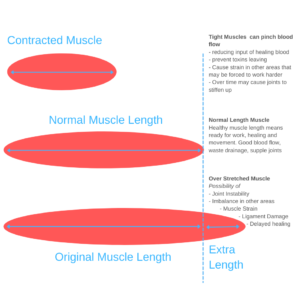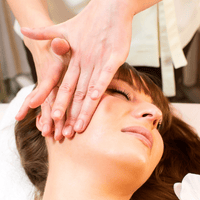The Science of Safe Stretches for Pain Relief
This article is for people who want a deeper insight into Safe Stretches
Need a safe way to exercise for pain relief? Stretching will help, but only if you know the safe way to do it. Pain can result from doing it incorrectly or too much.
Physical therapists often prescribe stretching as an exercise to help with pain relief, but few people know how to stretch safely for pain relief. They use the same stretches that they use when they are healthy.
So in this article I discuss the principles of stretch safely, delivering pain relief from muscle pain, joint pain, nerve pain and chronic pains.
Anatomy of Safe Stretches

When an area is freshly in pain, by definition it means there is an injury. The body’s response to injury is to protect itself with a muscle spasm. Initially the spasm will be along-side the injured area, ie on the same side as the injury.
Following the initial spasm, the muscles can tire if the person does not rest enough, or continues to push through the pain. The body then uses secondary muscles (ie muscles that are a little further away) to give support to the struggling muscles. Typically this may involve the muscles above and below the injury, or muscles on the opposite of the injury.
Strain or Spasm in Pain Relief
An important distinction to be aware of, is knowing if the area is in a spasm or if it is over-stretched.
Most of the time the patient will perceive the that a hurting area is in spasm. Why ? It is impossible for a person touching a very hot object and a very cold object and to know which is which. In the same way it is equally difficult for us to tell the difference between a muscle spasm and an over-stretched injury.
Safe Stretching for Pain Relief
When we seek pain relief, we need to remember pain arises because the area is injured. That means it has been over-strained. As a result of the over-strain the muscles tighten up to protect the area and prevent further straining (ie over-stretching). So the last thing the body needs is for the person to start stretching an area that is already over-strained.
Acute Pain
Being totally in spasm is not ideal. During an acute episode there is some benefit in introducing a very small amount of movement. This will allow a little more blood to get in (for healing) and a little more waste products to leave (toxins). And over time, the introduction of the very small movement can also help speed healing, getting you back on your feet again.
However, please be aware that there is a fine line here. The tipping point between creating enough movement for healing and the risk of inducing a tear is quite high. We recommend you leave this part to your trained osteopath, and wait to stretch after the acute episode is passed.
Safe Stretches At Home
There are two steps of note: (i) Restore original muscle length only (ii) Where to apply the safe-stretch
Effects of Over-Stretching a Muscle
***Click Image to view Infographic***
(i) Restore original muscle length
To accomplish a safe-stretch it is important that you stretch to only restore the muscle to it’s normal length, ie not to create new length. Please see info-graphic.
Over-lengthening an area (ie over-stretching it) can lead to a “floppier” area, requiring more muscles tone to hold it steady.
(ii) Where to apply the Safe-stretch
A person in pain will often stretch both sides, or worse, focus on stretching only the sore side.
Is this what we should be doing? Remember, when injury strikes the muscles do the only thing they can do, lock-up. This is done to protect the injured area.

What Not To Do
Bearing this in mind there seems to be little benefit in stretching an area that is already over-strained (ie injured) when the body is doing it’s best to protect that injury, by way of a protective spasm. For this reason, we suggest you avoid stretching the injured area.
Similarly there is little merit in directly massaging an area that is already suffering and in pain. The random act of rubbing an injured area (that is struggling to hold itself together), is only likely to add to the injury.
What To Do
As mentioned before, after a time when the protective muscle spasm starts to fatigue, the body asks more muscle groups for help – secondary muscles. These secondary muscles may include the muscles on the opposite side of the body, the area above the injury, or the area below the injury. Together they form a team effort.
Simply put, if you are in pain, stretch or massage these areas, leaving the injured area well alone. This may sound counter-intuitive, but it is safe, helpful and it works. You can apply hot or cold to the injury – see our blog here for more information.
Main thing to remember is by keeping the secondary muscles healthy, the core muscle splinting the injury can continue working.
Keep breathing
During any exercise it is important to breathe. People give conflicting rules whether to breathe in or breath out as you stretch. The truth is you can do either as both have different benefits.
Safest is to breathe out as you stretch. This way the muscles relax as you breath out and you receive a more relaxed stretch.
Breathing in during a stretch is more powerful, but also potentially riskier. Doing this works one muscle against another to relax it – a bit like when we stretch in the morning. So do this carefully. It can be a bit like driving with the brakes on.
Pain Away and Feel Great!

When done correctly safe stretching doesn’t just feel nice – it feels great! It can offer real pain relief. In the long run it can help muscles perform better and prevent injuries.
Stretching is a safe way to help you recover from muscle pain and joint pain. It reduces tension, calms the nervous system, and improves circulation. Muscle stretching can help relieve common conditions like back pain, sciatica, plantar fasciitis, tendinitis and more.
The bottom line: stretching regularly can reduce your chances of hurting yourself by providing flexibility to body. A flexible body will absorb errant forces, reducing the chances of spraining a single joint or tissue. Being flexible can also help speed up recovery time and it increases blood flow to your muscles and joints.
Summary of the Principles of Safe Stretching for Pain Relief

Ask me your question
Fill in a form click here
Email me click here
Fill in form to receive articles just like this when they are published.
– fill in the optional section to get discounts / offers on our treatments.
Vispi Jamooji DO PG Cert SPOP
Registered Osteopath (London, 1986)
Specialist Paediatric Osteopath & Cranial Osteopath
Living Centre Clinic
32 Durham Road, Raynes Park, London SW20 0TW
better@livingcentreclinic.com
020 8946 2331












